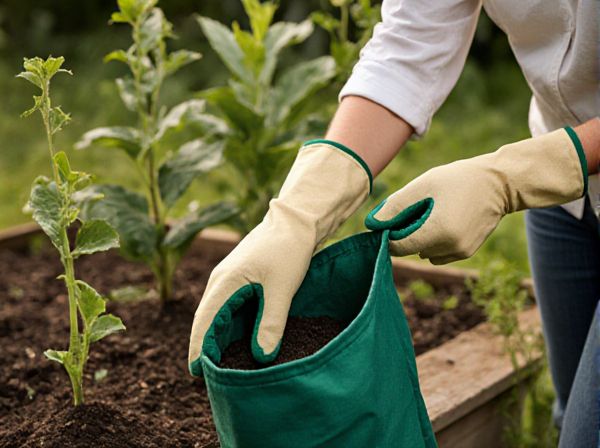
Fabric grow bags vs ceramic pots Illustration
Fabric grow bags offer superior aeration and drainage compared to ceramic pots, promoting healthier root development and preventing root rot. Unlike ceramic pots, fabric bags are lightweight and easy to move, making them ideal for seasonal gardening or limited space. Their breathable material helps regulate soil temperature, enhancing plant growth and overall container gardening success.
Table of Comparison
| Feature | Fabric Grow Bags | Ceramic Pots |
|---|---|---|
| Material | Breathable non-woven fabric | Clay-based ceramic |
| Air Circulation | Excellent, promotes root aeration | Limited, can cause root suffocation |
| Drainage | Superior natural drainage | Depends on bottom holes |
| Weight | Lightweight and portable | Heavy and less portable |
| Durability | Moderate lifespan, UV resistant | Long-lasting but prone to cracking |
| Root Health | Prevents root circling and promotes healthy root pruning | Roots may circle and become root bound |
| Cost | Generally affordable and cost-effective | More expensive upfront |
| Insulation | Moderate, can dry out faster | Good thermal insulation for roots |
| Aesthetic | Functional, less decorative | Highly decorative and customizable |
Introduction to Fabric Grow Bags and Ceramic Pots
Fabric grow bags offer superior aeration and drainage compared to ceramic pots, promoting healthier root development and preventing root circling. Ceramic pots, known for their durability and classic aesthetic, provide excellent moisture retention but can lead to waterlogging if not properly managed. Both containers serve unique purposes in gardening, with fabric bags favored for their lightweight, breathable material and ceramic pots valued for their stability and decorative appeal.
Material Composition: Fabric vs Ceramic
Fabric grow bags are made from breathable, non-woven polypropylene or natural fibers that promote air pruning and enhanced root aeration, preventing root circling and improving plant health. Ceramic pots consist of dense, fired clay materials that provide excellent durability and moisture retention but can restrict airflow to the root system, potentially leading to root rot. The porous nature of fabric bags allows superior drainage and temperature regulation compared to the solid, less permeable structure of ceramic containers.
Drainage and Aeration Differences
Fabric grow bags provide superior drainage due to their porous material, preventing waterlogging and promoting healthy root development. The breathable fabric enhances aeration by allowing air to penetrate the root zone, reducing the risk of root rot and improving oxygen availability. In contrast, ceramic pots often have limited drainage holes and non-porous surfaces, which can retain excess moisture and restrict airflow around the roots.
Root Health and Plant Growth
Fabric grow bags promote superior root health by allowing enhanced aeration and air pruning, which prevents root circling and encourages a dense, fibrous root system. In contrast, ceramic pots often restrict airflow and drainage, potentially leading to root rot and slower plant growth. Plants in fabric bags typically exhibit accelerated growth and improved nutrient uptake due to optimized oxygen availability and moisture regulation.
Temperature Regulation in Containers
Fabric grow bags offer superior temperature regulation compared to ceramic pots by allowing better air circulation and root aeration, which helps prevent overheating and root stress. Ceramic pots tend to retain heat, leading to higher soil temperatures that can stress plants during hot weather. The breathable nature of fabric bags promotes a cooler root environment, enhancing overall plant health and growth.
Portability and Storage Convenience
Fabric grow bags offer superior portability due to their lightweight and flexible design, making them easy to move and rearrange compared to heavier ceramic pots. Unlike rigid ceramic containers, fabric grow bags can be folded flat, significantly reducing storage space requirements when not in use. This flexibility and compact storage capability make fabric grow bags an ideal choice for gardeners with limited space or those needing frequent plant relocation.
Durability and Longevity
Fabric grow bags offer superior durability with their breathable, tear-resistant materials that prevent root circling and promote healthy plant growth, lasting several growing seasons when properly maintained. Ceramic pots, while aesthetically appealing and sturdy, are more prone to cracking or chipping under extreme temperature changes, often reducing their longevity. Opting for fabric grow bags enhances container lifespan and plant health in various climates due to their flexible, weather-resistant construction.
Environmental Impact and Sustainability
Fabric grow bags offer superior environmental benefits over ceramic pots due to their biodegradable materials and reduced carbon footprint during production. Unlike ceramic pots, which require high-energy kiln firing and result in heavier transportation emissions, fabric bags are lightweight, reusable, and often made from recycled or natural fibers. Their enhanced breathability also promotes healthier root systems, reducing plant stress and decreasing the need for frequent repotting or soil replacement.
Cost Comparison and Budget Considerations
Fabric grow bags typically cost 30-50% less than ceramic pots, making them a more budget-friendly option for container gardening. Their lightweight and flexible material reduces shipping and handling expenses, contributing to overall savings. Ceramic pots require higher upfront investment due to heavier materials and artisanal production, impacting long-term budget allocation.
Best Use Cases: Which Plants Thrive?
Fabric grow bags excel in promoting root aeration and drainage, making them ideal for vegetables like tomatoes, peppers, and root crops such as carrots and radishes that require well-drained soil. Ceramic pots excel at retaining moisture and temperature stability, favoring plants like succulents, cacti, and tropical houseplants which thrive in consistent moisture and moderate heat. For optimal plant growth, select fabric bags for fast-draining, aeration-sensitive species and ceramic pots for moisture-loving or temperature-sensitive plants.
Fabric grow bags vs ceramic pots Infographic

 gardendif.com
gardendif.com